How Do Butterflies Understand Colors?
Butterflies possess an extraordinarily sophisticated visual system featuring compound eyes with thousands of ommatidia, enabling them to see a broad spectrum of colors. Their vision extends into the ultraviolet range, well beyond human trichromatic vision.
With up to 15 types of photoreceptor cells, butterflies can discern intricate UV patterns, detect blue and green hues, and perceive red, aiding in foraging and mate selection. The interplay of these diverse photoreceptors underpins their nuanced color discrimination, essential for ecological interactions and survival strategies.
This unique visual capability offers deeper insights into their behavior and evolutionary adaptations.

Key Takeaways
- Butterflies can see a vast spectrum of colors, including ultraviolet light, which is invisible to humans.
- They possess up to 15 types of photoreceptor cells, enabling intricate color discrimination.
- UV-sensitive photoreceptors allow butterflies to detect UV patterns on flowers and wings.
- Blue, green, and red-sensitive photoreceptors enhance their ability to perceive various hues in their environment.
Anatomy of Butterfly Eyes
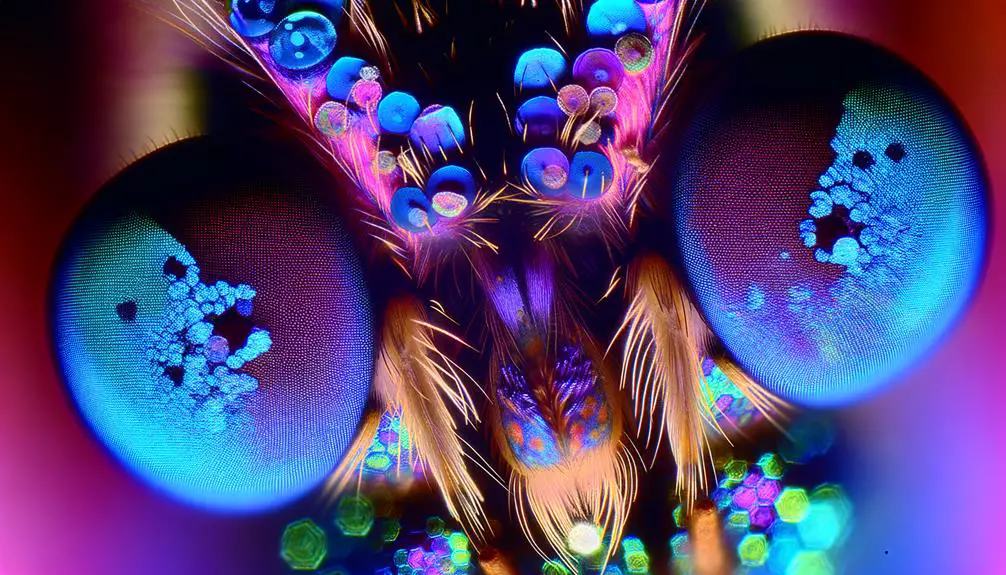
Butterfly eyes, known as compound eyes, are composed of thousands of individual units called ommatidia, each contributing to the insect's overall vision.
Each ommatidium functions as a tiny, independent photoreceptive unit, consisting of a cornea, lens, and photoreceptor cells. The corneal surface of each ommatidium focuses light onto the photoreceptor cells beneath.
This intricate arrangement allows butterflies to detect a wide range of wavelengths and perceive fine spatial details. The angular positioning of ommatidia varies across the eye, enabling a broad field of view and acute motion detection.
Such structural complexity provides butterflies with the ability to efficiently navigate their environment, locate nectar sources, and identify potential mates, enhancing their survival and reproductive success.
Photoreceptor Cells in Butterflies
Butterflies possess a remarkable array of photoreceptor cells, with some species having up to 15 different types, far surpassing the trichromatic vision seen in humans.
These photoreceptors enable butterflies to perceive an extensive spectrum of colors, including ultraviolet light.
The intricate mechanism of color vision in butterflies involves the interaction of these photoreceptors, which allows for nuanced color discrimination essential for tasks such as foraging and mate selection.
Types of Photoreceptors
In the domain of butterfly vision, photoreceptor cells are categorized into multiple types, each specialized for detecting specific wavelengths of light. These photoreceptors include ultraviolet (UV), blue, and green-sensitive cells, which allow butterflies to perceive a broad spectrum.
Some species possess additional photoreceptors, enabling the detection of red and even polarized light. The diversity in photoreceptor types facilitates complex visual processing, essential for behaviors such as foraging, mating, and navigation.
The arrangement and density of these cells vary among species, reflecting their ecological niches and visual demands. This specialization underscores the evolutionary adaptations that have honed butterfly vision, equipping them to thrive in their respective environments.
Understanding these photoreceptor types is fundamental to comprehending the intricacies of butterfly vision.
Color Vision Mechanism
Exploring the color vision mechanism in butterflies reveals how the diverse types of photoreceptor cells operate in tandem to enable these insects to detect and differentiate a wide range of colors.
Butterflies possess an intricate array of photoreceptors, each tuned to different wavelengths of light. This rich sensory apparatus includes:
- Ultraviolet-sensitive photoreceptors: Allowing detection of UV patterns on flowers.
- Blue-sensitive photoreceptors: Facilitating the recognition of blue hues.
- Green-sensitive photoreceptors: Enhancing the ability to perceive green foliage.
- Red-sensitive photoreceptors: Differentiating red and orange shades.
These photoreceptors work synergistically, enabling butterflies to navigate their environment effectively, locate mates, and identify ideal foraging sites.
The complex interplay of these cells underscores the evolutionary sophistication of butterfly vision.
How Butterflies Perceive Colors
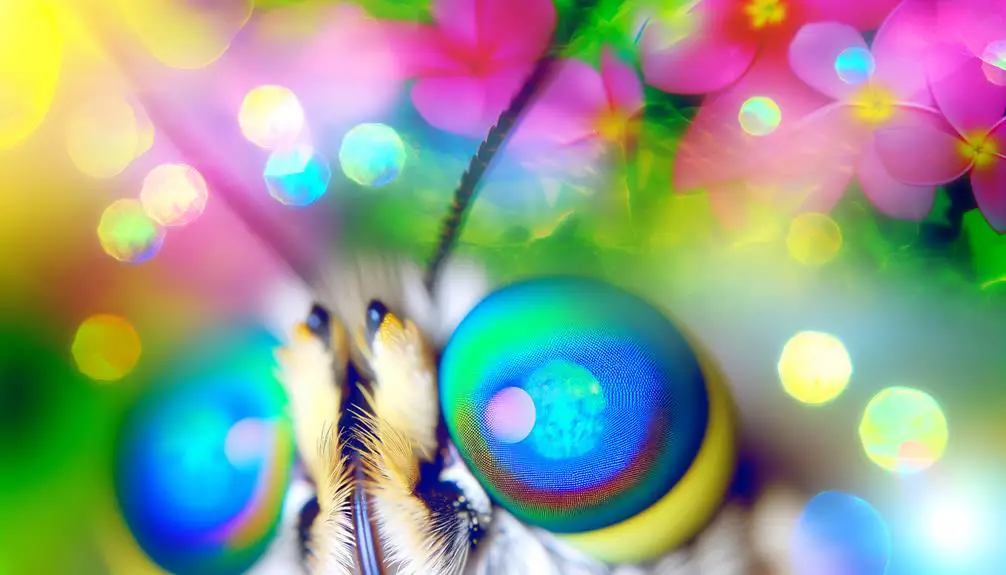
Butterflies possess a highly specialized visual system that includes an extraordinary sensitivity to ultraviolet light, which plays an essential role in their foraging and mating behaviors.
Their eyes contain multiple types of photoreceptor cells tuned to a broad spectrum of wavelengths, enabling them to perceive a wider range of colors than humans.
These adaptations provide butterflies with the ability to detect and discern intricate color patterns on flowers and potential mates, vital for their survival and reproductive success.
Ultraviolet Light Sensitivity
Ultraviolet light sensitivity in butterflies allows them to perceive a spectrum of colors beyond human visual capabilities, enhancing their ability to locate nectar sources and potential mates. This sensitivity is facilitated by specialized photoreceptor cells in their compound eyes, which detect ultraviolet wavelengths.
These adaptations provide several ecological advantages:
- Flower identification: UV patterns on flowers are invisible to humans but guide butterflies to nectar.
- Mate selection: UV-reflective scales on wings aid in recognizing conspecifics and selecting mates.
- Predator avoidance: UV markings can act as camouflage or warning signals.
- Navigation: UV light aids in orientation during flight.
These capabilities illustrate the complex visual system butterflies employ for survival and reproduction.
Color Vision Adaptations
In addition to their ultraviolet sensitivity, butterflies possess a highly specialized visual system that allows them to perceive a broad spectrum of colors through multiple types of photoreceptor cells.
Unlike humans, who typically have three types of photoreceptors for red, green, and blue, butterflies can have up to 15 different types. This diversity in photoreceptor cells enables them to detect a wider range of wavelengths, including those in the ultraviolet and polarized light spectra.
Such adaptations are essential for their survival, aiding in tasks like locating nectar-rich flowers, evading predators, and selecting mates based on subtle color cues.
These visual capabilities underscore the intricate evolutionary pressures that have shaped the sophisticated color vision in butterflies. This advanced perception allows butterflies to detect subtle differences in hues, which is crucial for identifying mates and suitable flowers for feeding. The butterfly bright colors meaning often relates to signaling toxicity to predators or attracting potential mates through vivid displays. Over time, these adaptations have enhanced their survival and reproductive success in diverse environments.
Ultraviolet Vision in Butterflies
Many species within the Lepidoptera order possess a specialized visual system that includes the ability to perceive ultraviolet light. This capability is facilitated by the presence of UV-sensitive photoreceptor cells in their compound eyes. Butterflies use ultraviolet vision to navigate their environment and locate resources essential for survival.
Key aspects of ultraviolet vision in butterflies include:
- Detection of UV Patterns: Many flowers exhibit UV-reflective patterns invisible to the human eye.
- Species Recognition: UV markings on wings help butterflies identify conspecifics.
- Mate Selection: UV patterns play a role in sexual selection, aiding in the attraction of mates.
- Foraging: UV vision enhances the ability to locate nectar sources.
This complex visual system underscores the adaptive significance of ultraviolet vision in butterflies.
Role of Color in Butterfly Behavior
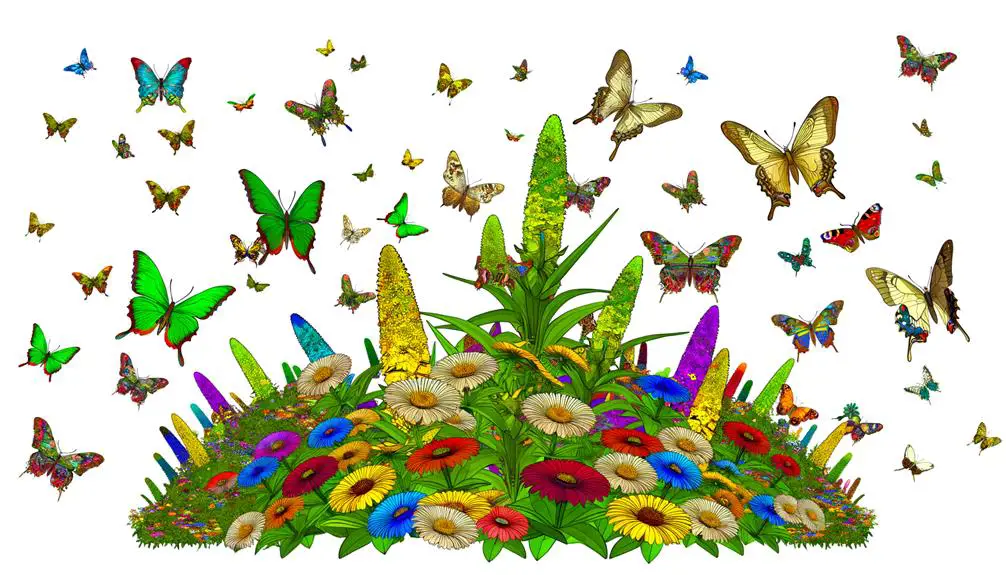
The perception of color significantly influences various behavioral aspects of butterflies, including foraging, mating, and predator avoidance. Butterflies utilize their acute color vision to identify and select flowers rich in nectar, which is essential for their energy intake. This ability enables them to differentiate between flowers based on color, enhancing foraging efficiency. In predator avoidance, butterflies employ color vision to detect and evade threats, relying on the contrast between their vibrant wing patterns and the environment.
| Behavior | Role of Color |
|---|---|
| Foraging | Identifies nectar-rich flowers |
| Predator Avoidance | Detects and evades threats |
| Navigation | Assists in orientation and locating habitats |
Understanding these color-driven behaviors underscores the sophisticated visual systems that aid butterflies in survival.
Color and Butterfly Mating
Butterfly mating behaviors are intricately linked to color signals, which play an essential role in mate attraction and selection. These vibrant visual cues facilitate communication between potential mates, ensuring successful reproduction.
Scientific studies reveal that butterflies utilize color patterns to assess mate quality and compatibility. Key observations include:
- Ultraviolet Markings: Many species possess ultraviolet reflectance, invisible to humans but vital for butterfly vision.
- Sexual Dimorphism: Males and females often display distinct color patterns, aiding in gender identification.
- Species-Specific Colors: Unique chromatic signatures help prevent interspecies mating.
- Environmental Influence: Local flora influences the evolution of butterfly coloration to enhance mating success.
These elements underscore the significant role of color in butterfly reproductive strategies.
Finding Food With Color Vision

Butterflies utilize their sophisticated color vision to locate and identify flowers rich in nectar, which is essential for their sustenance and energy. Their compound eyes are equipped with photoreceptor cells sensitive to a broad spectrum of wavelengths, including ultraviolet light, which is invisible to humans.
This advanced visual system allows butterflies to discern subtle color variations and patterns on flowers that signal the presence of nectar. Studies have shown that butterflies are particularly attracted to red, yellow, and purple hues, which often correspond to high-nectar-producing flora.
The ability to detect these specific wavelengths enables butterflies to efficiently forage and maximize their energy intake, ensuring their survival and reproductive success. This intricate form of visual perception underscores the interdependence between butterflies and flowering plants.
Environmental Navigation
Leveraging their advanced color vision, butterflies navigate complex environments by detecting and interpreting a diverse array of visual cues. This capability allows them to efficiently locate resources and avoid predators. Their compound eyes are sensitive to a broad spectrum of light, including ultraviolet, which is invisible to humans. This sensitivity aids in distinguishing subtle variations in their surroundings.
Key factors enhancing butterfly navigation:
- Ultraviolet Patterns: Many flowers and leaves reflect ultraviolet light, guiding butterflies to nectar sources.
- Polarized Light Detection: Helps in orientation and migration by interpreting the sky's polarization pattern.
- Color Gradients: Assist in identifying landmarks and habitats.
- Motion Detection: Enables tracking of moving objects and predator avoidance.
Thus, butterflies' sophisticated visual systems are integral to their environmental navigation.
Comparison to Human Vision
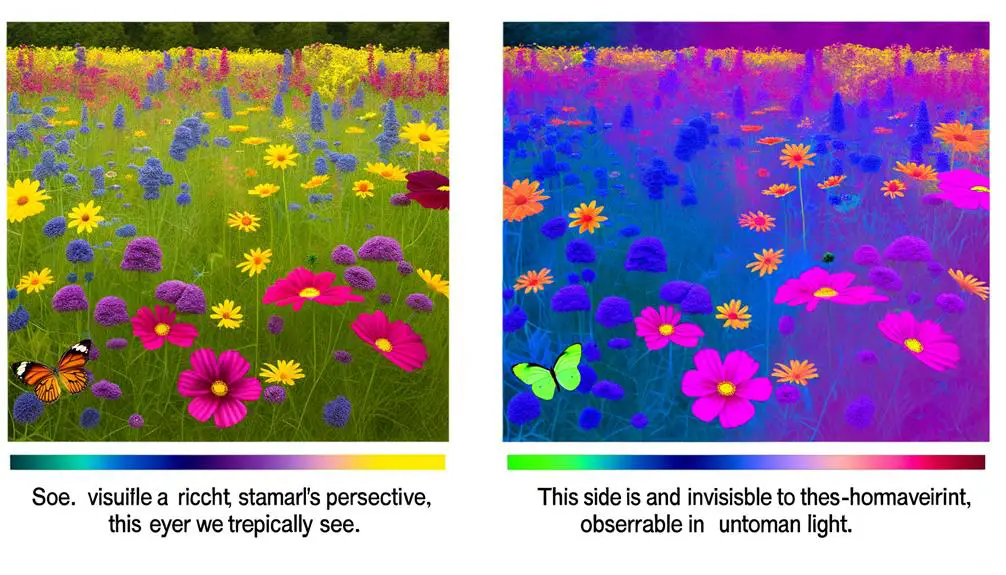
Comparing the visual capabilities of butterflies to human vision reveals significant differences in spectral sensitivity and color perception.
While humans possess three types of photoreceptor cells (cones) sensitive to red, green, and blue wavelengths, butterflies often have a broader range of photoreceptors, sometimes numbering up to fifteen.
This expanded range allows butterflies to perceive ultraviolet (UV) light, which is invisible to humans.
Additionally, butterflies can detect polarization patterns in light, aiding in navigation and mate selection.
These advanced visual capabilities enable butterflies to identify floral patterns, assess nectar availability, and recognize conspecifics with greater precision.
Consequently, the butterfly's visual system is highly adapted to its ecological niche, providing advantages in foraging and reproduction that are distinct from human visual experiences.
Evolution of Butterfly Vision
The evolutionary trajectory of butterfly vision is marked by the diversification of photoreceptor cells, enabling a wide array of color discrimination and UV sensitivity. This evolutionary advancement has equipped butterflies with sophisticated visual systems, optimized for their ecological interactions.
Key evolutionary developments include:
- Increased Photoreceptor Diversity: Butterflies possess multiple types of photoreceptors, enhancing their ability to discern a broad spectrum of colors.
- UV Sensitivity: Many butterfly species have evolved UV-sensitive photoreceptors, aiding in mate selection and foraging.
- Specialized Ommatidia: Compound eyes with specialized ommatidia improve resolution and color perception.
- Genetic Adaptations: Mutations in opsin genes have facilitated the expansion of spectral sensitivities.
These evolutionary adaptations underscore the complexity and specialization of butterfly vision.
Scientific Studies on Butterfly Vision
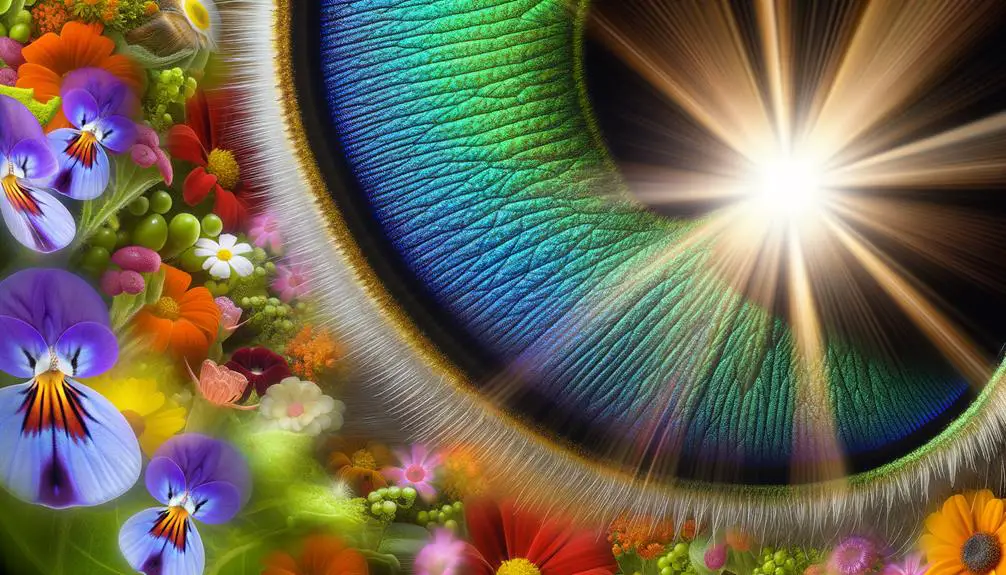
Numerous scientific studies have meticulously investigated the intricacies of butterfly vision, revealing a sophisticated system attuned to their ecological needs.
Researchers have discovered that butterflies possess compound eyes with numerous ommatidia, each containing multiple photoreceptor cells. These photoreceptors are sensitive to a broad spectrum of light, including ultraviolet (UV), blue, and green wavelengths.
Behavioral experiments and electrophysiological recordings have confirmed that butterflies can discriminate colors beyond human visual capabilities, such as UV patterns on flowers, which are invisible to us.
Advanced genetic analyses have also identified diverse opsin proteins responsible for their expanded color perception, facilitating essential activities like nectar foraging and mate selection.
This intricate visual system underscores the evolutionary adaptation of butterflies to their environments.
Conclusion
The intricate vision system of butterflies, characterized by specialized photoreceptor cells and the ability to perceive ultraviolet light, plays an essential role in their behavior and environmental navigation.
For instance, the Heliconius butterfly utilizes ultraviolet vision to distinguish between host plants, ensuring ideal oviposition sites.
This complex visual capability, evolved distinctly from human vision, underscores the adaptive significance of color perception in butterflies, further illuminated by numerous scientific studies exploring these phenomena.






